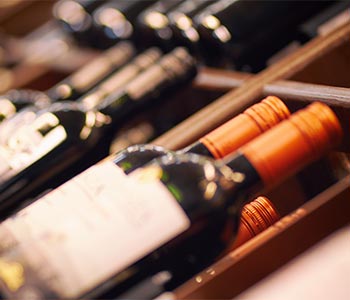
On the misunderstanding of "organic versus sustainable viticulture"
It has become a somewhat tiresome topic. Regional and supra-regional wine sustainability certifications that stir the emotions. Organic winegrowers who rightly feel stepped on their toes and yet usually lack a view of the bigger picture. And as always, it's all down to communication. An attempt at rectification.
April 2021
Quicktranslation with DeepL
Austria's winegrowers' association began working on a national sustainability label for wine more than ten years ago, which was launched in 2014 under the name "Sustainable Austria". Other countries and regions followed suit, and now even Great Britain has its own wine sustainability label. What they all have in common is, on the one hand, a noble goal and, on the other hand, a low entry level and the accusation of greenwashing. In this country, therefore, the feelings always run high. Especially in spring, when pictures of certified vineyards with herbicide strips do the rounds on social media.
A particular cause for wild discussion was a recent article (in German) by Juliane Fischer published in the Viennese weekly newspaper "Falter" and intensively discussed on Facebook. Is organic better than sustainable or vice versa and what is this actually about?
Well, I think there is a fundamental misunderstanding here. If we think of the three pillars of sustainability - ecology, economy, society - it quickly becomes clear that (organic) viticulture fits in here and that you cannot divide things up. You can read about the areas covered by the three pillars in viticulture in compact form in my presentation "Thinking about the future of winemaking". The term sustainability in its inflationary use in general and in viticulture through seals like "Sustainable Austria" in particular has been watered down over the years. If there were a better word, it would probably have been replaced long ago.
SO WHAT EXACTLY IS THIS ZERTIFICATION SUSTAINABLE AUSTRIA?<b< Take ten minutes of your time, and after watching this film by the University of St. Gallen, all your questions will be answered. At the very beginning, there is the explicit commitment of a company, an organisation, an industry, a region or an entire country to sustainability. Furthermore, to incorporate this into the overall strategy and to think about it at all levels. The next step is to engage in intensive debate in the form of a materiality analysis: Where do I have a - significant - influence on ecology, economy and society? And conversely, what is essential for my prosperity and survival? Only when I know these answers can I start planning. Support and guidance are available at many levels. Be it that one adheres to the guidelines and specifications for the preparation of a sustainability report (e.g. GRI) and, if necessary, also prepares this report as a positive side effect. Or that one works on a guideline such as ISO26000 (an international standard for sustainable organisations). Or that, ideally, a corresponding strategy for the sector already exists and one can immediately start implementing it. Sustainable Austria would be such a strategy for viticulture and includes all relevant criteria.
Sustainable Austria was developed on the basis of scientific research in cooperation with renowned institutes, and the findings have been incorporated into a comprehensive sustainability strategy for the wine sector. (If you are interested, you can read them in chapter 10 of my paper "Evaluation of the sustainability certification Nachhaltig Austria for Austrian viticulture, taking into account the Sustainable Development Goals and specific stakeholder needs". in German from 2016). Sustainable Austria carefully maps all areas - and this is unfortunately where the hymn ends. For its implementation, the requirements for certification have been levelled down. The entry level was set so low that certification is possible and as easy as possible for as many winegrowers as possible. Because of course it is also about money and the national and international reputation of this certification. Instead of clear guidelines and prohibitions, there are recommendations. Instead of targets (where are the climate targets??), there is standstill.
Back to the materiality analysis. What is the most essential thing for a winery? It is the soil! The economic strength and the continuity of the farm stands and falls with it. If the soil is healthy, it will feed me and my family for a long time. If it has a high level of biodiversity, it acts as a CO2 sink and contributes to the well-being of society. If it is depleted and lacks vegetation, it emits CO2 and contributes to climate change. If it is depleted, it also loses value from a financial perspective. If, on the other hand, it is vital and rich in humus, its market value increases. The true value of soil has actually arrived in the financial world, see more under True Cost Accouting of Soil! We also recommend this striking 5-minute film Let's Talk About Soil by the World Food Institute (in German).
A wine sustainability label therefore has the task of protecting the soil and promoting its biodiversity. Chemical-synthetic herbicides and pesticides should be banned. Furthermore, great effort and research support is needed for the replacement of copper and sulphur. The results of INBIODYN, a comparative experimental project at the University of Geisenheim on conventional, organic and biodynamic viticulture, have been published by Master of Wine Romana Echensberger in her book "Von der Freiheit, den richtigen Wein zu machen" (On the freedom to make the right wine), published in 2020 and summarised here. Copper, for example, is processed differently depending on soil fertility.
SO WHAT EXACTLY IS THIS ZERTIFICATION SUSTAINABLE AUSTRIA?
An Austrian sustainability label and an uncomplicated guideline for a winemaking sustainability strategy and
- guidelines for sustainable viticulture
- a practical timetable through all core areas
- a self-evaluation tool
- a certification by independent inspecting bodies (e.g. Lacon)
Why the sustainability label was created
- due to pressure from the retail food undustry (their own certifications)
- to create an internationally comparable system
- to tackle climate change
- to meet the consumer demand for sustainable wines
Advantages & disadvantages of "Certified Sustainable Austria"
Advantages:
- simple entry
- a guide through all three pillars
- covers all areas
- reduced complexity
- provides a quick overview
- low-threshold
- self-evaluation free of charge
- cost-effective audit
Disadvantages:
- consumers expect organic
- chemical-synthetic herbicides and pesticides (except glyphosate) are allowed
- many recommendations instead of clear guidelines
- therefore low participation by organic farms
- recertification only every three years
- evaluation not given in key figures
- no target requirements (climate targets!)
- little known among consumers
Possible development steps & goals: Certified Sustainable Austria & Certified Sustainable Austria Gold. With the requirements listed here, Austria would be an international pioneer and could position itself worldwide as the only truly sustainable wine country:
- Results also as valid key performance indicators (KPI) and not just as a diagram. Only when I know where I stand can I decide where I am going.
- mandatory conformity with climate targets (40% CO2 reduction by 2030, share of energy from renewable sources of at least 32%, increase in energy efficiency by at least 32.5%)
- ban on chemical-synthetic herbicides & pesticides
- clearer guidelines instead of recommendations (biodiversity!)
- stricter controls
- annual re-certification
- Sustainable Austria Gold = organic as an incentive for the next level




